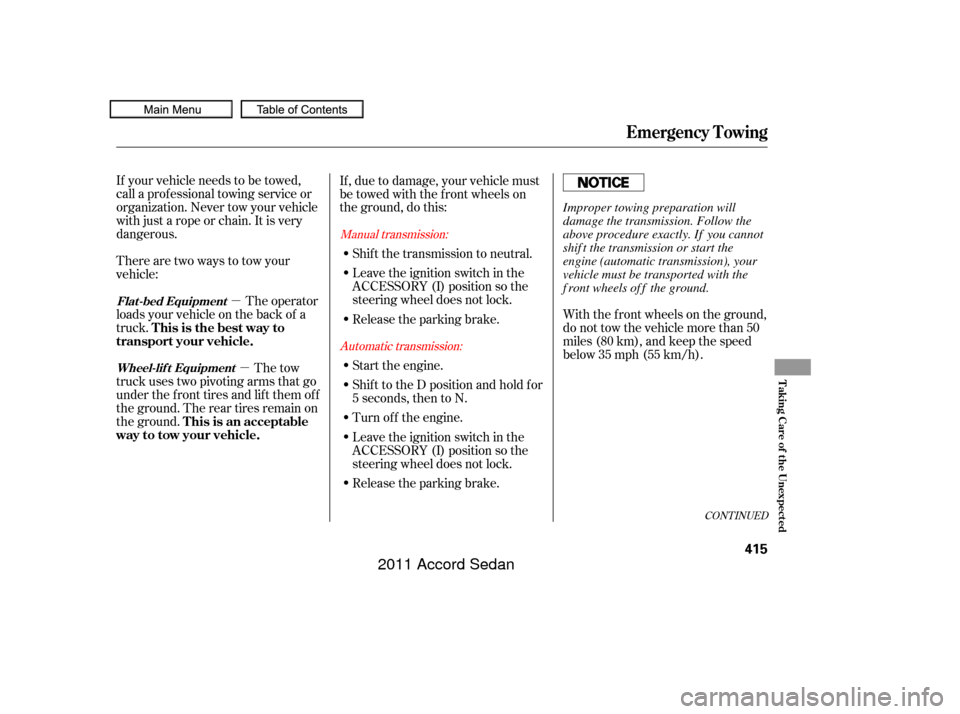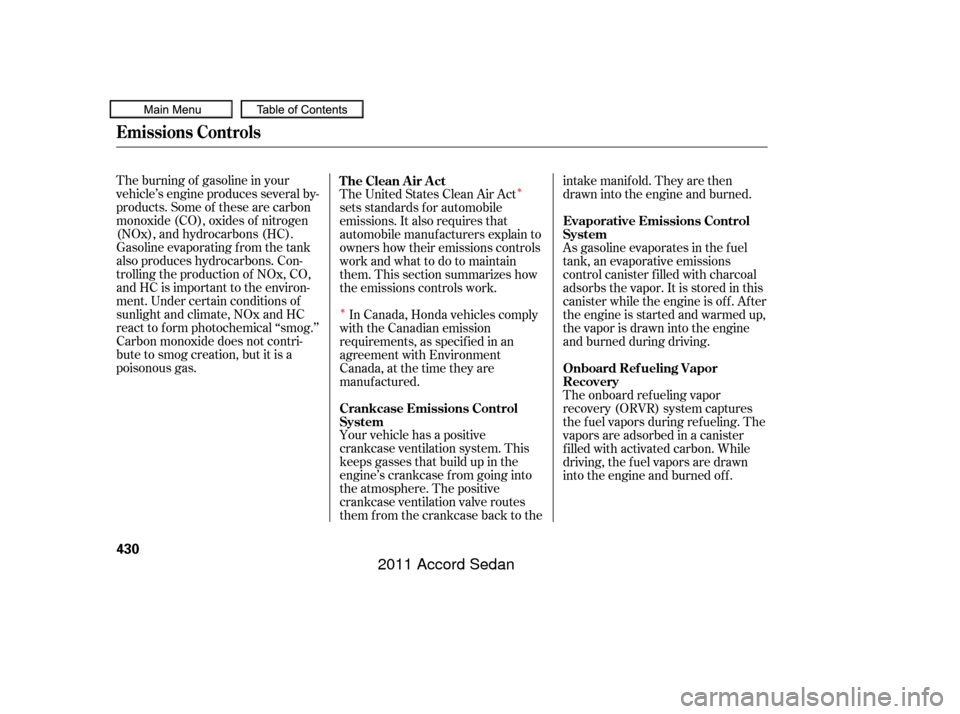Page 418 of 454

�µ�µ
If your vehicle needs to be towed,
call a prof essional towing service or
organization. Never tow your vehicle
with just a rope or chain. It is very
dangerous.
The operator
loads your vehicle on the back of a
truck. Therearetwowaystotowyour
vehicle: If , due to damage, your vehicle must
be towed with the f ront wheels on
the ground, do this:
With the f ront wheels on the ground,
do not tow the vehicle more than 50
miles (80 km), and keep the speed
below35mph(55km/h).
The tow
truck uses two pivoting arms that go
under the f ront tires and lif t them of f
the ground. The rear tires remain on
the ground.
Release the parking brake. Start the engine. Shif t the transmission to neutral.
Leave the ignition switch in the
ACCESSORY (I) position so the
steering wheel does not lock.
Release the parking brake.
Shif t to the D position and hold f or
5 seconds, then to N.
Turn of f the engine.
Leave the ignition switch in the
ACCESSORY (I) position so the
steering wheel does not lock.
Manual transmission:
Automatic transmission:
CONT INUED
Flat -bed EquipmentWheel-lif t Equipment
T his is the best way to
transport your vehicle.
This is an acceptable
way to tow your vehicle.
Emergency Towing
T aking Care of t he Unexpect ed
415
Improper towing preparation will
damage the transmission. Follow the
above procedure exactly. If you cannot
shif t the transmission or start the
engine (automatic transmission), your
vehicle must be transported with the
f ront wheels of f the ground.
10/06/18 16:35:56 31TA5630_420
2011 Accord Sedan
Page 421 of 454
Your vehicle has several identif ying
numbers in various places.
The vehicle identif ication number
(VIN) is the 17-digit number your
dealer uses to register your vehicle
f or warranty purposes. It is also
necessary f or licensing and insuring
your vehicle. The easiest place to
find the VIN is on a plate fastened to
the top of the dashboard. You can
seeitbylookingthroughthe
windshield on the driver’s side. It is
also on the certification label
attached to the driver’s doorjamb,
and is stamped on the engine
compartment bulkhead. The VIN is
also provided in bar code on the
certif ication label.
Identif ication Numbers
418
CERTIFICATION LABEL
VEHICLE IDENTIFICATION NUMBER (VIN)
10/06/18 16:36:07 31TA5630_423
2011 Accord Sedan
Page 422 of 454
The transmission number is on a
label on top of the transmission. The engine number is stamped on
the f ront of the engine block.
Identif ication Numbers
Technical Inf ormation
419
ENGINE NUMBER
V6 models
AUTOMATIC TRANSMISSION NUMBER
ENGINE NUMBER
AUTOMATIC
TRANSMISSION
NUMBER
MANUAL TRANSMISSION NUMBER
4-cylinder models
10/06/18 16:36:12 31TA5630_424
2011 Accord Sedan
Page 423 of 454

�µ�µ�Î
�Î
�Î�Î
�Î
�Î
�Î
�Î
Specif ications (4-cylinder models)
420
DimensionsSeating Capacities
Weights
Air Conditioning
Engine Capacities
110.2 in (2,800 mm)
62.6 in (1,590 mm)
Length
Width
Height
Wheelbase
Track 194.1 in (4,930 mm)
72.7 in (1,847 mm)
58.1 in (1,475 mm)
2.1 US qt (2.0
)
2.0 US qt (1.9)
5.4 US qt (5.1)
4.0 US qt (3.8)
4.2 US qt (4.0)
1.96 US gal (7.4
)
1.90 US gal (7.2)
1.64 US gal (6.2
)
1.59 US gal (6.0)
5
2
3
62.2 in (1,580 mm) Total
Front
Rear
Gross vehicle weight rating See the certification label attached to the driver’s doorjamb.
Refrigerant type
Charge quantity
Lubricant type HFC-134a (R-134a)
14.1 15.9 oz (400 450 g) ND-OIL8
Water cooled 4-stroke
DOHC i-VTEC 4-cylinder gasoline engine
3.43 x 3.9 in (87.0 x 99.0 mm) 144 cu-in (2,354 cm
)
10.5 : 1
ILZKR7B11S
SXU22HCR11S
Type
BorexStroke
Displacement
Compression ratio
Spark plugs (U.S.)
Spark plugs (Canada)
SXU22HCR11S ILZKR7B11S
DILZKR7B11GS 18.5 US gal (70.0
)
Excluding the oil remaining in the engine Including the coolant in the reserve tank and that remaining in the
engine
Reserve tank capacity: 0.180 US gal (0.68
)
Fuel tank
Engine
coolant
Engine oil
Manual
transmission
fluid
Automatic
transmission
fluid
Windshield
washer
reservoir
4.8 US qt (4.5
)
2.6 US qt (2.5)
6.50 US qt (6.15
)
2.6 US qt (2.5)
Approx.
Change Manual
Automatic
Total Manual
Automatic
1:
2:
NGK:
DENSO:
Front/Rear
ULEV
PZEV
1:
2: EX,EX-L
NGK:
NGK:
DENSO:
LX, LX-P, SE
ChangeIncluding filter
Without filter
Total
Change
Total
Change
Total
U.S.
Canada
1
1
2
2
10/07/09 15:58:41 31TA5630_425
2011 Accord Sedan
Page 424 of 454

�µ
�µ
�µ
�µ
�µ
�µ
�µ
�Î �Î
�Î
�Î
�Î �Î
�Î
�Î �Î
Specif ications (4-cylinder models)
Technical Inf ormation
421
Lights
Battery Fuses
Tires
Alignment
Headlights
Front turn signal/parking lights
Front side marker lights
Rear turn signal lights
Back-up lights
Stop/taillights
License plate lights
High-mount brake light
Ceiling light
Spotlights
Trunk light
Front door courtesy lights
Vanity mirror lights
Capacity
12 V
12 V
12 V
12 V
12 V
12 V 36 AH/5 HR
38 AH/5 HR
45 AH/20 HR
47 AH/20 HR
52 AH/5 HR
65 AH/20 HR Interior
Under-hood
Size
Pressure
P215/60R16 94H
P225/50R17 93V
T135/80D16 101M
32 psi (220 kPa , 2.2 kgf/cm
)
30 psi (210 kPa , 2.1 kgf/cm)
60 psi (420 kPa , 4.2 kgf/cm
)
Toe-in
Camber
Caster 0.00 in (0.0 mm)
0.08 in (2.0 mm)
0°1°
3°48’
See page
413or the fuse label
attached on the side panel.
See page 414or the fuse label
attached to the inside of the fuse
box door.
See page 412or the fuse box
cover.
60 W (HB3)
51 W (HB4)
21/5 W
3CP
21 W
21 W
21/5 W
5W
21 W
8W
8W
5W
1.4 W 2CP
High
Low
: Passenger’s side Driver’s side
Front/Rear
Spare
Front/Rear
Spare
1:
2:
Front
Rear
Front
Rear
Front
PZEV engine model, and Canadian models LX, LX-P, SE
EX, EX-L
(Amber)
2
1
2 1
10/06/18 16:36:53 31TA5630_426
2011 Accord Sedan
Page 425 of 454

�µ�µ�Î
�Î
�Î �Î
Specif ications (V6 models)
422
Dimensions Seating Capacities
Weights
Air Conditioning
Engine Capacities
110.2 in (2,800 mm)
Length
Width
Height
Wheelbase
Track 194.3 in (4,936 mm)
72.7 in (1,847 mm)
58.1 in (1,475 mm)
62.2 in (1,580 mm)Total
Front
Rear
5
2
3
1.74 US gal (6.6
)
2.27 US gal (8.6)
4.5 US qt (4.3
)
5.3 US qt (5.0
)
3.5 US qt (3.3)
7.9 US qt (7.5)
2.6 US qt (2.5
)
4.8 US qt (4.5)
Including the coolant in the reserve tank and that remaining in the
engine
Reserve tank capacity:
Excluding the oil remaining in the engine 0.180 US gal (0.68
)
Gross vehicle weight rating See the certification label attached
to the driver’s doorjamb.
Refrigerant type
Charge quantity
Lubricant type HFC-134a (R-134a)
14.1 15.9 oz (400 450 g) ND-OIL8
3.50 x 3.66 in (89.0 x 93.0 mm) 212 cu-in (3,471 cm
)
10.5 : 1
ILZKR7B11
SXU22HCR11 18.5 US gal (70.0
)
Water cooled 4-stroke
SOHC i-VTEC 6-cylinder (V6) gasoline engine 4.2 US qt (4.0
)
Type
BorexStroke
Displacement
Compression ratio
Spark plugs (U.S.)
Spark plugs (Canada) ILZKR7B11
SXU22HCR11 Fuel tank
Engine
coolant
Engine oil
Automatic
transmission
fluid
Windshield
washer
reservoir
Approx.
1:
2: Change
Including filter
Without filter
Total
Change
Total
U.S.
Canada Change
Total
Front/Rear
NGK:
DENSO:
NGK:
DENSO:
2 1
10/06/18 16:37:10 31TA5630_427
2011 Accord Sedan
Page 433 of 454

�Î
�ÎThe burning of gasoline in your
vehicle’s engine produces several by-
products. Some of these are carbon
monoxide (CO), oxides of nitrogen
(NOx), and hydrocarbons (HC).
Gasoline evaporating f rom the tank
also produces hydrocarbons. Con-
trolling the production of NOx, CO,
and HC is important to the environ-
ment. Under certain conditions of
sunlight and climate, NOx and HC
react to f orm photochemical ‘‘smog.’’
Carbon monoxide does not contri-
bute to smog creation, but it is a
poisonous gas. The United States Clean Air Act
sets standards f or automobile
emissions. It also requires that
automobile manufacturers explain to
owners how their emissions controls
workandwhattodotomaintain
them. This section summarizes how
the emissions controls work.
In Canada, Honda vehicles comply
with the Canadian emission
requirements, as specif ied in an
agreement with Environment
Canada, at the time they are
manuf actured.
Your vehicle has a positive
crankcase ventilation system. This
keeps gasses that build up in the
engine’s crankcase f rom going into
the atmosphere. The positive
crankcase ventilation valve routes
them from the crankcase back to the intake manif old. They are then
drawn into the engine and burned.
As gasoline evaporates in the f uel
tank, an evaporative emissions
control canister f illed with charcoal
adsorbs the vapor. It is stored in this
canister while the engine is of f . Af ter
the engine is started and warmed up,
the vapor is drawn into the engine
and burned during driving.
The onboard ref ueling vapor
recovery (ORVR) system captures
the f uel vapors during ref ueling. The
vapors are adsorbed in a canister
f illed with activated carbon. While
driving, the f uel vapors are drawn
into the engine and burned of f .
The Clean Air Act
Crankcase Emissions Control
System
Evaporative Emissions Control
System
Onboard Ref ueling Vapor
Recovery
Emissions Cont rols
430
10/06/18 16:38:22 31TA5630_435
2011 Accord Sedan
Page 434 of 454

The exhaust emissions controls
includethreeorfoursystems:
PGM-FI, ignition timing control,
exhaust gas recirculation (6-cylinder
models), and three way catalytic
converter. These systems work
together to control the engine’s
combustion and minimize the
amount of HC, CO, and NOx that
come out the tailpipe. The exhaust
emissions control systems are
separate f rom the crankcase and
evaporative emissions control
systems.The emissions control systems are
covered by warranties separate
from the rest of your vehicle.
Read your warranty manual for
more information. The emissions control systems are
designed and certif ied to work to-
gether in reducing emissions to
levels that comply with the Clean Air
Act. To make sure the emissions
remain low, you should use only new
Honda replacement parts or their
equivalent f or repairs. Using lower
qualitypartsmayincreasethe
emissions f rom your vehicle. The three way catalytic converter is
in the exhaust system. Through
chemical reactions, it converts HC,
CO, and NOx in the engine’s exhaust
to carbon dioxide (CO ), nitrogen
(N ), and water vapor.
The PGM-FI system uses sequential
multiport f uel injection. It has three
subsystems: air intake, engine
control, and f uel control. The
powertrain control module (PCM) in
automatic transmission vehicles or
the engine control module (ECM) in
manual transmission vehicles uses
various sensors to determine how much air is going into the engine. It
then controls how much f uel to inject
under all operating conditions.
The exhaust gas recirculation (EGR)
system takes some of the exhaust
gas and routes it back into the intake
manifold. Adding exhaust gas to the
air/fuel mixture reduces the amount
of NOx produced when the fuel is
burned. This system constantly adjusts the
ignition timing, reducing the amount
of HC, CO, and NOx produced.
2
2
V6 models
Exhaust Emissions Controls
Replacement Parts
Emissions Cont rols
Three Way Catalytic Converter
PGM-FI System Exhaust Gas Recirculat ion (EGR)
Syst em
Ignit ion T iming Cont rol Syst em
Technical Inf ormation
431
10/06/18 16:38:31 31TA5630_436
2011 Accord Sedan